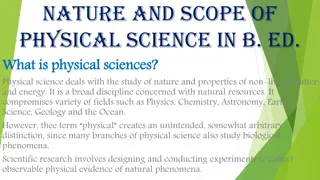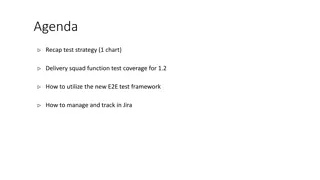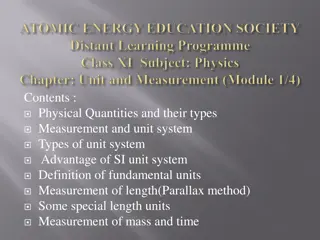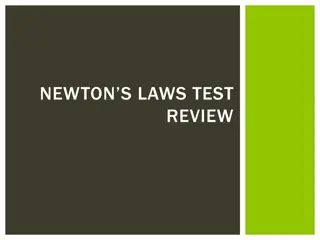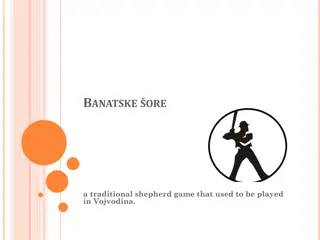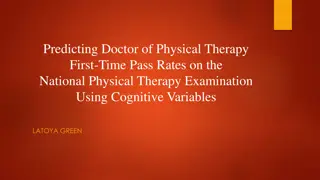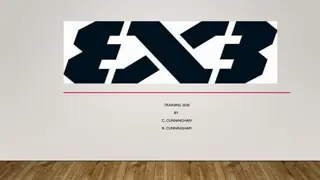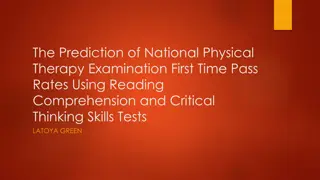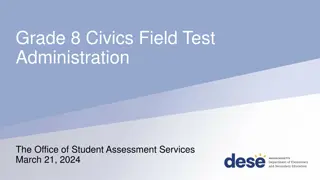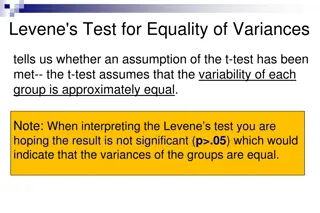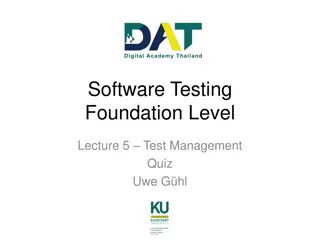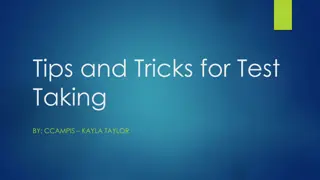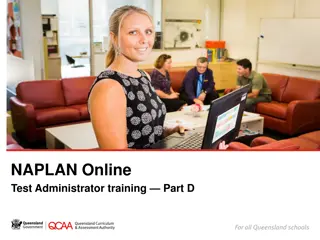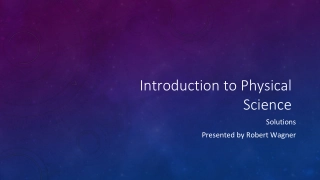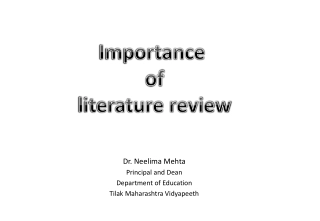Physical Science Unit 1 Test Review Game
This test review game covers various topics in physical science including concepts like floating and sinking, forces, work, inertia, acceleration, and more. It presents multiple-choice questions with explanations related to lifeguard tests, object forces, average force calculations, work calculations, inertia investigations, mechanical advantage, acceleration calculations, and comparative animal speeds.
Download Presentation

Please find below an Image/Link to download the presentation.
The content on the website is provided AS IS for your information and personal use only. It may not be sold, licensed, or shared on other websites without obtaining consent from the author. Download presentation by click this link. If you encounter any issues during the download, it is possible that the publisher has removed the file from their server.
E N D
Presentation Transcript
Physical Science Unit 1 Test Review Game
Question 1 Wayne wants to become a lifeguard. For part of the lifeguard test, he has to float in the pool for five minutes. Why does Wayne float instead of sinking to the bottom of the pool? A. The water pushes Wayne up against gravity. B. Gravity pushes Wayne up against the water. C. Wayne does not weigh very much. D. Wayne weighs too much. a
Question 2 What force, in newtons, is required to keep the object in the picture below at rest? A. 0 N B. 12 N C. 18 N D. 48 N b
Question 3 A student of mass 60 kilograms jumps from a laboratory counter. At the instant he lands on the floor, his speed is 3 m/s. If he stops in 0.2 second, what is the average force on him? A. 1 10-2N B. 4 100N C. 1 102N D. 9 102N d
Question 4 A college student has just bought a small computer that weighs 50 N. To reach her apartment on the 5th floor, which is 35 meters up, she must climb the stairs. How much work must she do to take her computer up the stairs? A. 15 J B. 50 J C. 85 J D. 1750 J d
Question 5 A scientist is investigating the inertial of several objects. He records the following data: Which object has the greatest inertia? A. Bowling ball B. Toy wagon C. Bicycle D. Wheelbarrow d
Question 6 A construction crew must use a lever to lift a boulder. The mechanical advantage of the lever is 6 and the lever applies a force of 1600 N to the rock. What is the force that the construction crew must apply to the lever? A. 134 N B. 267 N C. 380 N D. 534 N b
Question 7 The velocity of a car changes uniformly from 60.0 meters per second north to 45 meters per second north in 5.0 seconds. What is the magnitude of the car's acceleration? A. 3.0 m/s2 B. 9.8 m/s2 C. 15 m/s2 D. 53 m/s2 a
Question 8 The speed limit for an average city road about 72 kilometers per hour. Which animals would receive a speeding ticket at their average speed? A. antelope, cheetah, gray fox B. antelope, cheetah, gazelle C. giraffe, gray fox, rabbit D. gazelle, giraffe, rabbit Animals Distance (km) Time (h) Gray fox 73 1.05 Gazelle 68 0.85 Rabbit 70 1.25 Cheetah 85 0.75 b Giraffe 60 1.15 Antelope 93 0.95
Question 9 Based on Newton's law of inertia, which object is moving at a steady speed, assuming that all four objects are moving on a frictionless surface? A. C. B. D. d
Question 10 What will happen to the mass of a ball if it is moved from Earth to the Moon? A. The mass will increase. B. The mass will decrease. C. The mass will not exist. D. The mass will remain the same. d
Question 11 A rock is taken from the Moon back to Earth. Which of the following correctly describes the changes to its mass and weight? A. Its mass increases, and its weight increases. B. Its mass has no change, and its weight decreases. C. Its mass decreases, and its weight has no change. D. Its mass has no change, and its weight increases. d
Question 12 What is the difference between mass and weight? A. Mass is the amount of matter in an object, and weight is the pull of gravity on an object. B. Weight is the amount of matter in an object, and Mass is the pull of gravity on an object. C. Mass is always more than weight D. Weight is always more than mass a
Question 13 The graph shows the relationship between speed and time for four cars, Q, R, S, and T, traveling on a straight road. Which car experienced the greatest average acceleration during this 6.0-second interval? A. Q B. R C. S D. T d
Question 14 If a rock and a feather are dropped in a 98-meterlong tube in which there is a vacuum, which one will hit the bottom first? A. The feather will hit the bottom first. B. The rock will hit the bottom first. C. Both will hit at the same time. D. More information is needed. c
Question 15 A screw driver acts as a lever when used to open a paint can. If Juan applies a force of 25 N to the handle of the screwdriver. What mechanical advantage does the screwdriver provide if it applies a force of 350 N to the lid? A. 0.08 B. 14 C. 325 D. 375 b
Question 16 Which pair of graphs represents the same motion of an object? A. C. O B. D.
Question 17 An airplane demonstrates the law of action- reaction because A. its forward force is balanced by wind resistance while it is cruising. B. when it lands, the ground pushes against the plane and slows it down. C. the force of its rudder moving to the right turns the plane to the right. D. its wings deflect air downward, and the air pushes the plane upward. d
Question 18 What is the measure of the gravitational force on Earth? A. mass B. weight C. energy D. inertia b
Question 19 Which of the following is a reason why a pendulum bob will never go higher than the height from which it is dropped? A. The gravitational force will pull down on the pendulum bob. B. The strong force will work on the pendulum bob. C. The pendulum bob will gain energy because of friction. D. The pendulum bob will lose energy because of friction. d
Question 20 During which of the following time intervals is the object traveling at a constant, positive velocity? A. 0-2 s B. 2-3 s C. 3-4 s D. 4-6 s a
Question 21 When will an object dropped from rest attain a speed of 30 m/s? A. approximately 1 seconds after being dropped B. approximately 2 seconds after being dropped C. approximately 3 seconds after being dropped D. approximately 4 seconds after being dropped c
Question 22 Samantha and Emily are pushing a box of textbooks in the same direction across their classroom. Samantha is applying a force of 10 newtons, and Emily is applying a force of 10 newtons. What is the net force of their efforts? A. 0 newtons B. 10 newtons C. 20 newtons D. 100 newtons c
Question 23 What is the total distance traveled by the object during the first 4 seconds? A. 5 m B. 20 m C. 40 m D. 80 m c
Question 24 If a car is traveling at an average speed of 60 kilometers per hour, how long does it take to travel 12 kilometers? A. 0.2 hour B. 0.5 hour C. 0.72 hour D. 5.0 hours a
Question 25 Why is the force of gravity on Earth stronger than on the Moon? A. The Moon is larger in size. B. The Moon has more mass. C. Earth is larger in size. D. Earth has more mass. d
Question 26 Which change in an object would increase the force needed to move the object? A. decreasing the velocity of an object B. increasing the volume of an object C. decreasing the mass of an object D. increasing the mass of an object d
Question 27 Mona has locked herself out of her house. She wants to use a crow bar to open the door. The effort length of the crowbar is 48 cm and mechanical advantage of the crowbar is 6. What is the resistance length of the crowbar? A. 6 cm B. 8 cm C. 10 cm D. 12 cm b
Question 28 A baseball player runs 27.4 meters from the batter's box to first base, overruns first base by 3.0 meters, and then returns to first base. How does the total distance traveled by the player compare to the magnitude of the player's displacement from the batter's box? A. The total distance is 3.0 m longer than the displacement. B. The total distance is 6.0 m shorter than the displacement. C. The total distance is 6.0 m longer than the displacement. D. The total distance is 3.0 m shorter than the displacement. c
Question 29 Dennis made a 500 km trip in five hours. For the first two hours, Dennis had an average speed of 150 km/h. For the last two hours, Dennis had an average speed of 100 km/h. Which of the following is true about Dennis' trip? A. Dennis must have maintained a constant velocity throughout his trip. B. Dennis must have maintained a constant speed throughout his trip. C. Dennis must have stopped for an hour in the middle of this trip. D. Dennis must have driven without stopping during his trip. c
Question 30 Two forces are applied to a 2.0-kilogram block on a frictionless, horizontal surface, as shown in the diagram below. What is the acceleration of the block? A.5.0 m/s2to the left B. 3.0 m/s2to the right C. 3.0 m/s2to the left D.5.0 m/s2to the right b
Question 31 If a crumpled piece of notebook paper and a flat sheet of notebook paper are dropped at the same time from the same height, why does the crumpled piece of paper land first? A.The crumpled paper has more gravitational force exerted on it. B. The flat paper has more air resistance. C. The flat paper has more mass. D.The crumpled paper has less mass. b
Question 32 Which of the following graphs best represents the relationship between the force applied to a body at rest and the body's resulting acceleration? A. C. B. D. b
Question 33 Jennifer watched as movers used a ramp to load a heavy dresser into a moving truck. The dresser, that had to be lifted 1.5 m from the street to the back of the moving truck, was pushed along a 6.6 m ramp. What is the mechanical advantage of the ramp? A. 2.98 B. 3.06 C. 4.0 D. 4.4 d
Question 34 If the sum of all the forces acting on a moving object is zero, the object will A. continue moving with constant velocity. B. change the direction of its motion. C. slow down and stop. D. accelerate uniformly. a
Question 35 Which of the following causes people in a moving car to continue moving forward, even when the car stops? A. inertia B. gravity C. friction D. tension a
Question 36 Which of the following objects would experience the greatest acceleration if the same unbalanced force were applied to each? A. An object of mass 1 kg B. An object of mass 2 kg C. An object of mass 3 kg D. An object of mass 4 kg a
Question 37 Charlie lifts a box with a force of 500 N and sets it on a table top 1.2 m above its starting position. Lauren pushes an identical box up a 5 m ramp from the floor to the top of the same table. Which person did more work? A. Charlie did more work. B. Lauren did more work. C. Both Charlie and Lauren did the same amount of work. D. The size of each individual must be known to determine who did more work. c
Question 38 A baker pushes a cart full of rolls with a force of 20.0 N for a distance of 4.0 m. How much work does the baker do on the cart? A. 0.20 J B. 5.0 J C. 16 J D. 80 J d
Question 39 Dennis made a 500 km trip in five hours. For the first two hours, Dennis had an average speed of 150 km/h. For the last two hours, Dennis had an average speed of 100 km/h. Which of the following is true about Dennis' trip? A. Dennis must have maintained a constant velocity throughout his trip. B. Dennis must have maintained a constant speed throughout his trip. C. Dennis must have stopped for an hour in the middle of this trip. D. Dennis must have driven without stopping during his trip. c
Question 40 The boat moves forward due to A. a forward thrust from the propeller that is greater than the backward force of the water current. B. a forward thrust from the propeller that is equal to the backward force of the water current. C. a backward thrust from the propeller against the water that is greater than the force of gravity. D. a backward thrust from the propeller against the water that is less than the force of gravity. a
Question 41 Newton s third law of motion describes a. net force. b. balanced forces. c. centripetal forces. d. action and reaction forces. d
Question 42 What is the acceleration of the block? a. 2.5 m/s2to the right b. 4.0 m/s2to the left c. 1.5 m/s2to the right d. 2.5 m/s2to the left d
Question 43 Which of the following objects has the greatest inertia? a. A 5.0 kg mass moving at 10.0 m/s. b. A 20.0 kg mass moving at 1.0 m/s. c. A 10.0 kg mass moving at 1.0 m/s. d. A 15 kg mass moving at 10.0 m/s. b
Question 44 Two forces are applied at the same time on a wooden box. Which diagram shows the forces positioned to give the box the GREATEST acceleration? a b c d a
Question 45 Which best describes what will happen to the box? a. It will move at a constant speed to the right. b. It will move at an increasing speed to the right. c. It will move at a constant speed to the left. d. It will move at an increasing speed to the b left.
Question 46 The mass of a newborn baby is 3.8 kilograms. What is the baby s weight? (The acceleration due to gravity at Earth s surface is 9.8 m/s2.) a. 0.387 N b. 372 N c. 37.2 N d. 3.87 N c
Question 47 Which force accounts for the difference between mass and weight? a. gravitational force b. frictional force c. magnetic force d. air resistance force a
Question 48 A small engine causes a 0.4-kg model airplane to accelerate at a rate of 12 m/s2. What is the net force on the model airplane? a. 30 N b. 3.0 N c. 4.8 N d. 48 N c
Question 49 If Malik weighs 100 N on Earth, and Alexander weighs 100 N on the Moon, how do their masses compare to one another? a. Malik s mass is greater than Alexander s. b. Alexander s mass is greater than Malik s. c. Malik and Alexander have the same mass. d. Alexander s and Malik s masses cannot be compared. b







